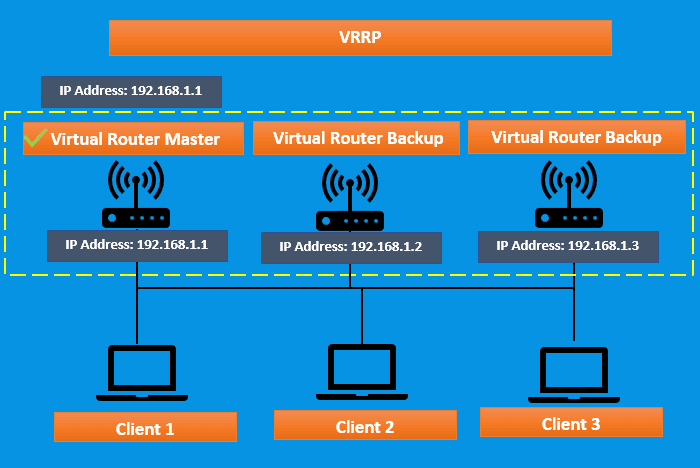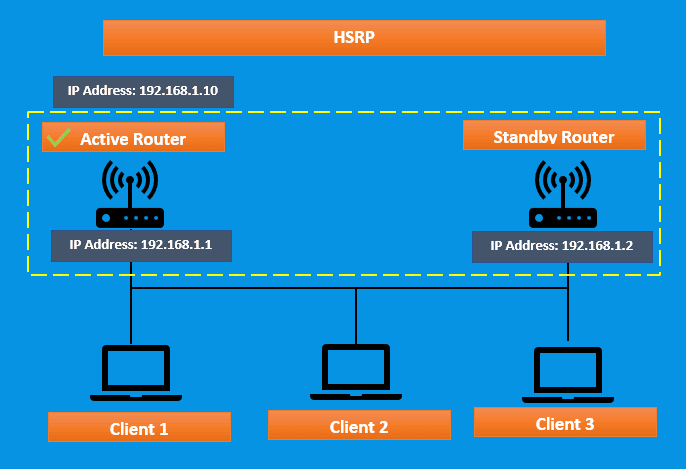1. Introduction
In network infrastructure, having multiple paths and devices available is important if the connection loses its strength. Hence, redundancy is crucial. Redundancy ensures that network traffic can continue to flow even in failure.
Furthermore, Virtual Router Redundancy Protocol (VRRP) and Hot Standby Router Protocol (HSRP) are two commonly used protocols that provide redundancy for a network.
In this tutorial, we’ll explore how VRRP and HSRP work, their common use cases, and their differences.
2. VRRP
VRRP is a protocol that provides redundancy for IP networks by allowing multiple routers to share a virtual IP address.
Specifically, it works by assigning one router as the master router and the others as the backup. In this case, the master router is responsible for forwarding packets sent to the virtual IP address. On the other hand, the backup routers are ready to take over if the master router fails.
2.1. How Does VRRP Work?
In VRRP, each router in the group sends messages to the other routers. In addition, these messages contain information about the router’s priority level, the virtual IP address, as well as the state of the router (whether it is the master or a backup). Furthermore, the router with the highest priority is elected as the master router, and it is responsible for forwarding packets sent to the virtual IP address.
If the master router fails, then the backup router with the highest priority takes over as the master router. Consequently, ensuring a router is always available to forward packets sent to the virtual IP address. Additionally, when the original master router returns online, it becomes a backup router and waits for the current master to fail before attempting to take over again.
The following figure shows the VRRP architecture:

3. HSRP
HSRP is a Cisco proprietary protocol that provides redundancy for IP networks. Like VRRP, HSRP allows multiple routers to share a virtual IP address since one router is designated as the active router and the other routers as standby routers.
3.1. How Does HSRP Work?
HSRP works in a similar way to VRRP. In which the router group sends out messages to each other. Then, the router with the highest priority is labeled as the active router.
If the main router fails, another router keeps packets flowing to the virtual IP address. Moreover, when the original router returns online, it waits until the current router fails before it takes over again.
The following figure shows the HSRP architecture:

4. Use Cases for VRRP and HSRP
VRRP and HSRP are commonly used in various network environments to provide redundancy and failover capabilities. Here are some common use cases for each protocol.
4.1. Use Cases for VRRP
VRRP provides several benefits to network infrastructure, including support for load balancing, high availability, and redundancy.
Moreover, it enables load balancing by allowing multiple routers to share the virtual IP address, which can help distribute network traffic across multiple routers and improve network performance.
Furthermore, VRRP ensures high availability by providing a backup router that can take over if the master router fails. This redundancy feature can help ensure that network traffic continues to flow even in the event of a failure, as multiple routers share the same virtual IP address and can take over if needed.
4.2. Use Cases for HSRP
It is the most common protocol in Cisco environments. Also, HSRP supports authentication, which can help ensure that only authorized devices can participate in the HSRP group. Hence, this can improve network security and prevent unauthorized access.
Furthermore, HSRP provides a backup router that can take over if the active router fails, ensuring high availability for network traffic.
5. Differences Between the VRRP and HSRP Protocols
Despite the similarities in providing redundancy and failover capabilities in network environments, VRRP and HSRP differ in several key aspects, such as protocol type, router identification, priority configuration, load balancing, and compatibility.
The following table summarizes the differences between these two protocols:
6. Conclusion
In conclusion, VRRP and HSRP are useful protocols for ensuring network redundancy, failover capabilities, and high availability.
Additionally, the selection of which protocol to use will depend on the specific requirements of the network environment and the equipment being used.